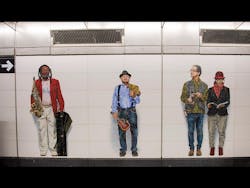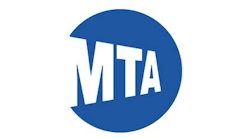Governor Cuomo Presents Largest Permanent Public Art Installation in New York History
"The Second Avenue subway provides New Yorkers with a museum underground and honors our legacy of building engineering marvels that elevate the human experience," Governor Cuomo said. "Public works projects are not just about function – they’re an expression of who we are and what we believe. Any child who has never walked into a museum or an art gallery can walk the streets of New York and be exposed to art and education simply by being a New Yorker. That is where we came from and that is what makes New York special."
The new stations will feature four world-class public art installations:
At 96th Street, “Blueprint for a Landscape” by Sarah Sze profoundly impacts the look of the station as her imagery is applied directly to nearly 4300 unique porcelain wall tiles, spanning approximately 14,000 square feet. The designs feature familiar objects – sheets of paper, scaffolding, birds, trees, and foliage – caught up in a whirlwind velocity that picks up speed and intensity as the composition unfolds throughout the station with references to energy fields and wind patterns. Each entrance features a different shade of blue and a blueprint-style vector line design, a visual theme that is integrated with the architecture.
At 86th Street, Chuck Close in “Subway Portraits” has created twelve large-scale works that are based on the artist’s painstakingly detailed photo-based portrait paintings. His various painting techniques have been interpreted in ten works as mosaic, and in two as ceramic tile. The artworks measure close to nine feet high and are placed on the walls at the station entrances and the mezzanine concourse. The people portrayed are cultural figures that have frequently been his subjects, including Philip Glass, Zhang Huan, Kara Walker, Alex Katz, Cecily Brown, Cindy Sherman, and Lou Reed, as well as two distinct self-portrait.
At 72nd Street, Vik Muniz’s installation, “Perfect Strangers” features more than three dozen characters created in mosaic and installed throughout the mezzanine and entrance areas, populating the station with colorful images of all types of New Yorkers. The main station entrance features an etched glass canopy at street level depicting a flock of birds, bringing art and nature to the busy location. Within the expanse of the mezzanine concourse, the life size figures provide bursts of color and visual interest and an opportunity for new discovery with every trip through the station.
At 63rd Street, Jean Shin’s installation, “Elevated” uses archival photographs of the 2nd and 3rd Avenue Elevated train to create compositions in ceramic tile, glass mosaic, and laminated glass. The imagery is manipulated and re-configured and each station level provides a unique focus, palette and material. At the escalator, the view is filled with ceramic tile depicting construction beams and the cranes that dismantled the El in the 1940s. At the mezzanine, a mosaic reveals the sky where the train had previously been present, and features images of people from the era in this neighborhood transformation. The platform level features semi-transparent and reflective materials showing vintage scenes of the neighborhood, while enabling contemporary viewers to see themselves in the cityscape of the past.
MTA Chairman and CEO Thomas F. Prendergast said, “There’s no doubt that the launch of these new stations represents an historic expansion of the system. But it also represents a major milestone in terms of culture -- the work of these four incredibly talented artists will provide a source of enjoyment, inspiration and beauty to both customers and visitors for decades to come.”
The Second Avenue Subway marks the most significant changes to New York City subway service in recent decades, and will be built in four phases. Phase I will provide service from 96th Street to 63rd Street and will serve more than 200,000 people per day, reducing overcrowding on the Lexington Avenue Line and restoring a transit link to a neighborhood that lost the Second Avenue Elevated in 1940.
Phase I will decrease crowding on the adjacent Lexington Avenue Line by as much as 13 percent, or 23,500 fewer riders on an average weekday. It will also reduce travel times by up to 10 minutes or more for those on the far east side or those traveling from the east side to west midtown. Further phases of the project will extend the line to Hanover Square in the Financial District.
The new stations will also provide transfers to other subway and commuter rail lines. All of the stations will have escalator and elevator access including access for the disabled, and will feature climate control features to maximize customer comfort.




